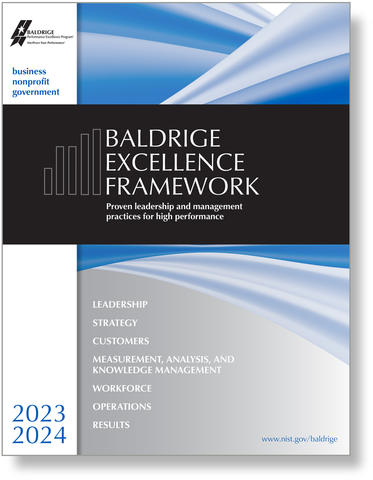Blogrige
The Official Baldrige Blog

The last few years have revealed substantial vulnerabilities in supply networks across industries, from the lack of pandemic-related equipment such as masks and ventilators in hospitals in 2020, and, recently, the supply problems that have led to higher-priced eggs. While strengthening supply networks has been addressed in the Baldrige Criteria for Performance Excellence® (part of the Baldrige Excellence Framework®) since its inception, the concept was further focused and refined in the 2023–2024 edition.
An August 2020 report by McKinsey Global Institute, “Risk, Resilience, and Rebalancing in Global Value Chains,” noted that in recent decades, supply chains have grown in length and complexity “in pursuit of margin improvements,” but that these chains often “were not calibrated to risk exposure." The report continues,
"Intricate [supply] networks were designed for efficiency, cost, and proximity to markets but not necessarily for transparency or resilience. Now they are operating in a world where disruptions are regular occurrences. Averaging across industries, companies can now expect supply-chain disruptions lasting a month or longer to occur every 3.7 years, and the most severe events take a major financial toll.”
Seven Baldrige-Aligned Steps for Improvement
Vora's Seven-Step Supply-Chain Improvement Plan
Even before the COVID pandemic hit, Dr. Manu K. Vora, president of Business Excellence, Inc., wrote the article “Seven Steps to Link Quality Improvement to Your Supply Chain” for Supply Chain Management Review on “how to build integrated and innovative supply chains in the twenty-first century by looking at the parallels between successful supply-chain and quality management practices within the context of [the Baldrige Criteria] and by leveraging insights” from ASQ’s Global State of Quality research.
“Supply-chain quality doesn’t happen by accident,” stated Vora. “Global supply-chain quality has to be an ongoing process that requires a comprehensive plan, . . . is part of an organization’s culture, and is intertwined with manufacturing processes.”
The Baldrige Criteria offer the questions that organizations should be asking themselves to ensure that they are following a roadmap to success. Vora linked his seven-step supply-chain improvement plan to the categories of the Baldrige Criteria as follows:
Step 1
Promote a culture of quality in the supply chain, with leaders supporting a clearly stated quality vision. (Baldrige category 1, Leadership)
Step 2
Create a supply-chain strategy with sound design and planning that supports the organization’s short- and long-term objectives. Strategy should include key outcomes, guided use of resources, workforce plans, performance measures and projections, and anticipated modifications. (Baldrige category 2, Strategy)
Step 3
Focus on the customer by soliciting complaints and resolving problems; using surveys, focus groups, and customer advisory boards; mapping the customer experience and leveraging data to flag problems in advance; and analyzing customer satisfaction, dissatisfaction, and engagement relative to competitors. (Baldrige category 3, Customers)
Step 4
Consider a roadmap for IT measurement and analysis that includes performance measurement, performance analysis and review, performance improvement, and technology management. (Baldrige category 4, Measurement, Analysis, and Knowledge Management)
Step 5
Review best practices on how to build and incentivize an effective and supportive supply-chain workforce and engage staff members to achieve organizational and personal success. (Baldrige category 5, Workforce)
Step 6
Consider work system design and work process design. (Baldrige category 6, Operations)
Step 7
Track a key set of metrics for customer information (reliability, responsiveness, and flexibility), along with internal information that includes costs and assets. (Baldrige category 7, Results)
“In a global economy, high-performing and high-quality supply chains are not only essential to delivering goods on time, [but] global companies also depend on their supply-chain processes to manage the divergent expectations of customers and suppliers, to stay one step ahead of the competition, and even to protect a company’s image,” wrote Vora.
Isaacson's Seven-Step Supply-Chain Improvement Plan
A related article I found interesting is “Seven Steps to Ensure Quality Across the Supply Chain” by David Isaacson, which appeared in the May 20, 2021, edition of SupplyChainBrain.
According to Isaacson, “Supply chain complexity continues to grow, along with the high price of product defects and recalls. . . . Implementing a quality-management approach across the supply chain not only minimizes the number of quality issues, but ensures that manufacturers and their suppliers all understand what is expected of them, so they can uphold the highest standards of quality. From the concept of a product to its final destination, quality is a journey that everyone is on together.”
Isaacson also suggested seven steps, which align with the Baldrige Criteria, specifically, with the text in section 6.2b on supply-network management, as follows:
Step 1
Establish a production part approval process with clear design specifications for compliance to standards. (Baldrige categories 6, Operations; and 7, Results)
Step 2
Set up a receiving and inspection process. (Baldrige category 6, Operations)
Step 3
Implement supplier corrective action requests, involving root-cause analysis, corrective planning, and risk analysis. (Baldrige category 6, Operations)
Step 4
Qualify suppliers and materials. (Baldrige category 6, Operations)
Step 5
Collect supplier ratings. (Baldrige category 6, Operations)
Step 6
Expand the role of supplier-quality management from just the quality team to everyone who has a relationship with your suppliers. (Baldrige categories 1, Leadership; 2, Strategy; 4, Measurement, Analysis, and Knowledge Management; and 6, Operations).
Step 7
Make suppliers part of your quality system. (Baldrige category 1, Leadership; 2, Strategy; 4, Measurement, Analysis, and Knowledge Management; and 6, Operations)
The Baldrige Take on Supply Networks and Resilience, and How It Supports the Steps

In the 2023-2024 Baldrige Excellence Framework®, the resilience of the supply network (what Baldrige considers the next evolution of the supply chain) is an important thread throughout categories, with a focus in category 6 in the section on operational effectiveness. The framework keeps a focus on suppliers in order to promote alignment and collaboration, mitigate risk and ensure agility and resilience, measure and evaluate performance, require and foster ethical behavior, enhance strategy, and ensure security and cybersecurity roles and responsibilities.
In the Criteria, supply networks are also considered among strategic challenges, threats, advantages, and opportunities, and in the section on safety, business continuity/resilience, and risk management in terms of reliance on an organization’s supply network.
Resilience is also an important—if not the most important—thread in the Criteria. An expected outcome of agility, resilience appears throughout the Criteria to help organizations understand and prepare for changing needs. Resilience today often means being prepared for business transformation—to be able and willing to respond quickly to both opportunities and threats, and to adapt strategy, action plans, workforce plans, and processes, when needed.
Vora and Isaacson have offered seven steps to improve and sustain supply chains. But the Baldrige Criteria offer the questions an organization needs to consider in order to accomplish those steps.

Baldrige Excellence Framework®
The Baldrige Excellence Framework® has empowered organizations to accomplish their missions, improve results, and become more competitive. It includes the Criteria for Performance Excellence®, core values and concepts, and guidelines for evaluating your processes and results.
Purchase your copy today!
Available versions: Business/Nonprofit, Education, and Health Care






It is also important to re-evaluate what is done in house versus by contract (Category 2). Some manufacturing and construction networks are so diversified that everything comes to a halt if one supplier is delayed, or worse, disappears. It's nice to think that a global supply network can be a Lean, Six Sigma machine delivering high quality components "just in time"; until geopolitics raises its head.